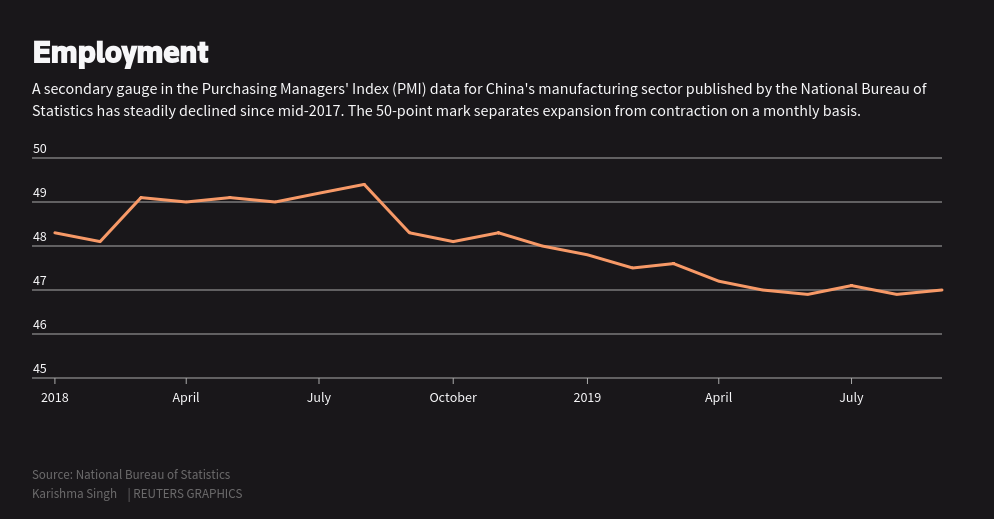BEIJING—China’s $13 trillion economy is slowing and indicators showing that range from freight shipments to factory power generation and from employment to expenditures on entertainment.
China releases gross domestic product data on Oct. 18, a key indicator for global growth since even small changes in China’s economic performance can have ripple effects for other major economies.
Economists expect China’s growth has slowed to near its lowest since 1990 because of the escalating trade conflict with the United States and weakening domestic demand. That slowdown appears to be deepening despite a weakening currency and steps by Beijing to provide stimulus, including cuts in taxes and fees equivalent to about $282 billion.
China’s third-quarter GDP is expected to grow 6.1 percent, according to a Reuters poll. Some analysts expect growth to have dipped beneath 6 percent for the quarter, below the bottom of the government’s growth target for 2019.
Manufacturing Jobs

While China’s official unemployment rate has remained steady, signs have emerged that sluggish domestic demand and trade friction with the United States have triggered increased layoffs in the country’s manufacturing sector.
An employment-tracking component of the Purchasing Manager’s Index (PMI)—a snapshot of conditions in the sector—has been trending sharply lower since last year. The August reading slipped below 47 for the first time since the global financial crisis.
Electrical Machinery Exports

Outbound shipments of electrical machinery began to contract at the end of last year. That contrasted with double-digit growth for most of 2018.
For 2019, exports have been falling, reflecting the toll U.S.-imposed tariffs are taking on Chinese manufacturers. The fall in September exports was the steepest in almost 10 months, excluding the February reading, which was distorted by seasonal factors.
Rail Freight

Annual growth in the volume of freight delivered over China’s more than 100,000 kilometers of railway lines has tapered each month since end-2017 as domestic demand has softened.
Compared with the double-digit percentage monthly gains previously, railway freight has mostly eased to single-digit growth or even outright declines. The slowdown has come despite a reduction—or in some cases a cancellation—of freight charges by state-run China Railway Corp in April this year to support the economy.
Electricity Generation

China’s electric power industry, the world’s largest, is a key gauge of the activity in the country’s industrial sector.
Growth in electricity generation has slowed visibly since the second half of last year to the lowest in three years.
Auto Sales

China’s car sales declined last year for the first time since the 1990s. In September, sales of autos, which account for about a tenth of all retail sales, fell for a 15th straight month, dampening hopes for any quick turnaround in the world’s largest auto market.
Besides autos, Chinese consumers are scaling back purchases on everything from smartphones to furniture, as income growth slows and debt levels creep higher.
Box Office Revenue

China’s 2018 movie box office revenue slowed from a year earlier, growing just 9 percent to the equivalent of $8.6 billion. That compared with nearly 13.5 percent growth in 2017.
The slowdown in the world’s second-largest film market after the United States has further deepened this year as consumers tightened spending.
Box office revenue last month slipped to the lowest since September 2018, according to Reuters calculations based on daily statistics provided by the official China Movie Data Information Network.





